
Sep '08 - Sep '11

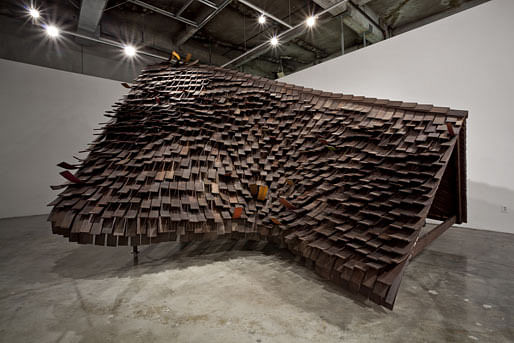
photos by Joshua White, courtesy Jason Payne
In honor of its closing Sunday, I wanted to post some thoughts and reporting on the opening of Jason Payne’s (my final research studio professor) installation at SCI-Arc. The installation in SCI-Arc’s gallery was titled “Rawhide: The New Shingle Style” and focused on Jason’s Raspberry Fields project for a house in Utah. Included in the show were the scale model of the house as well as a full scale 1:1 construction of an important segment of the house’s roof. Originally plans were to include cow hides surrounding the 1:1 installation, conceptually “refigured as abstract bodies” to reinforce the connection to hair and hides in the work. Inhabiting the space with these flattened forms would have helped the exhibition succeed more thoroughly as an installation in a gallery; however the 1:1 segment of the house is absolutely successful as an affecting object of interest, and it’s only slightly less so at filling the specific SCI-Arc gallery space.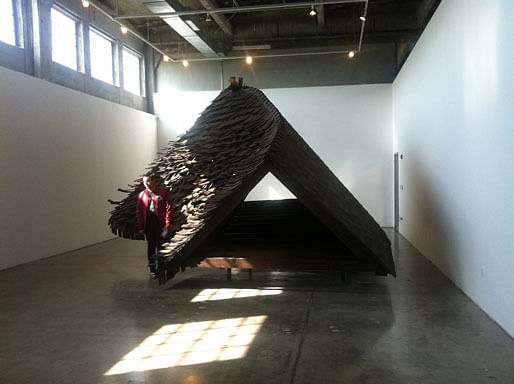
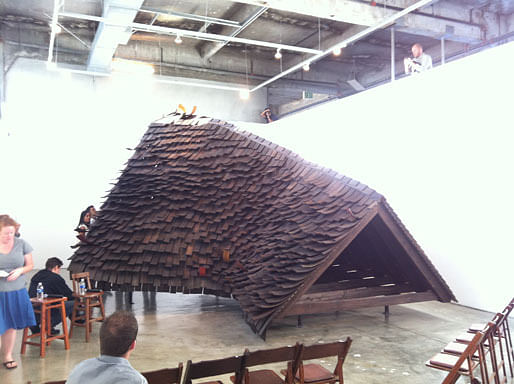
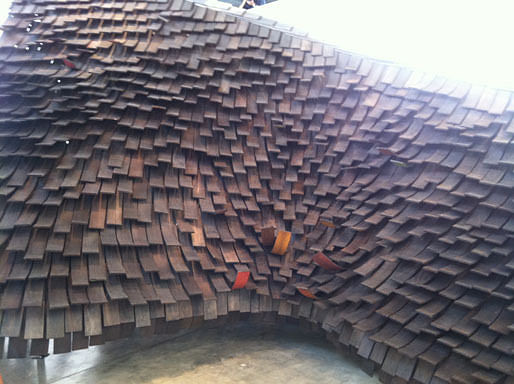
The Raspberry Fields model is among my favorite architectural models, so I’m glad it was prominently featured in the exhibition. I actually wish the full scale house installation hewed more closely to the design laid out in the model, especially the detail at the apex of the roof, and the far richer coloration of the shingle undersides of the model versus the 1:1 version.



I hope some of the details not included in the 1:1 installation make it into the final house, especially the eaves curl and the window fringe “hairstyle”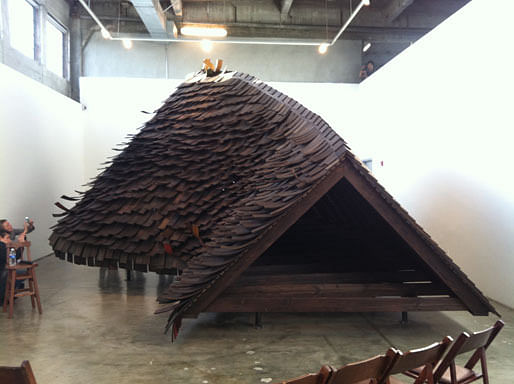
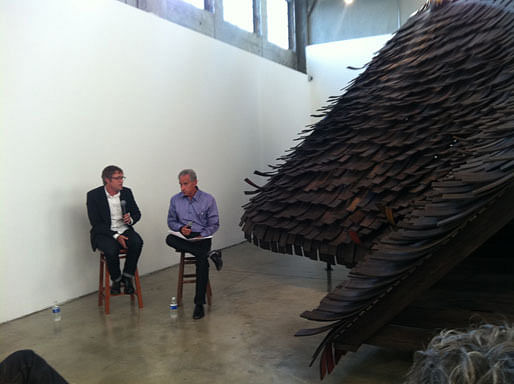
Jason and EOM
The opening night of the installation on July 29 included a conversation between Jason and SCI-Arc head EOM (Eric Owen Moss), who actually seemed to be on his best behavior - far less crotchety and contrarian than usual. He began the discussion by attempting to dismiss Jason’s longtime interest in hair, one of the formal drivers of Raspberry Fields project, by saying “hair doesn’t seem that serious” as an architectural interest. Jason expanded on hair, saying it was introduced to his architectural work as an ‘extradisciplinary influence’ and as a way to productively distance himself from existing interests in architecture, and as a logical extension of previous work. He stated that he was once interested in the topological project in architecture, but became increasingly dissatisfied with smooth bald surfaces; the introduction of hair reinvests a “clean smooth surface” with more interest.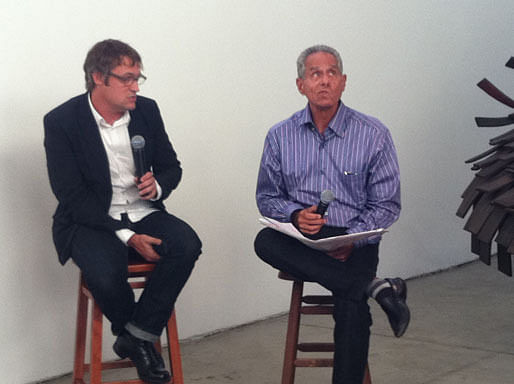
EOM pondering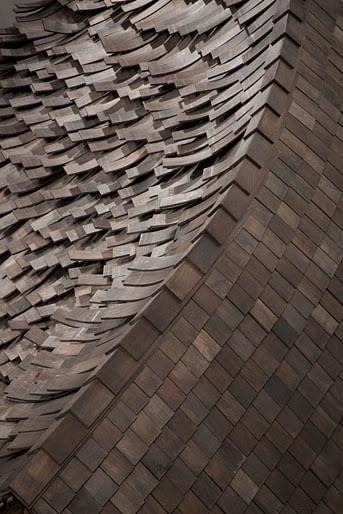
somewhere I heard someone describe the house as a mullet - “business in the front, party out back”
photo by Joshua White, courtesy Jason Payne
Many of EOM’s comments served to bring in extra-disciplinary references to the Raspberry Fields project as well as to Jason’s use of hirsutism or hairiness in architecture; some refs with more relevance than others. These included the hair shirt in Catholicism, which is a coarse garment of animal hair used “to induce some degree of discomfort or pain as a sign of repentance and atonement” (which I as a second generation atheist/agnostic of course had to look up). EOM went on a short pseudo-psychoanalytic tear about self mortification and whether Jason used hair as a subconscious repentance for anything. Jason responded with a simple “No, I’m not Catholic.”
This is one of the better images that come up when one googles “hair shirt”
Another ref included Vince Scully’s Nantucket House, which EOM made special mention to due to Jason’s show’s subtitle, “The New Shingle Style”, as Vincent Scully’s book The Shingle Style of Today extolled the virtues of regional vernacular homes in New England. EOM accused Jason of a sort of regression to vernacular postmodernism in emphasizing shingles. Jason responded that he recognizes the conservative implications and that postmodernism was indeed wrapped up in Raspberry Fields, but hopefully as a perversion of or “swerve” away from Scully’s shingle style. He insisted that looking back at Scully’s shingle style, it actually has a lot to do with mass, form, and posture beyond simple cladding material.
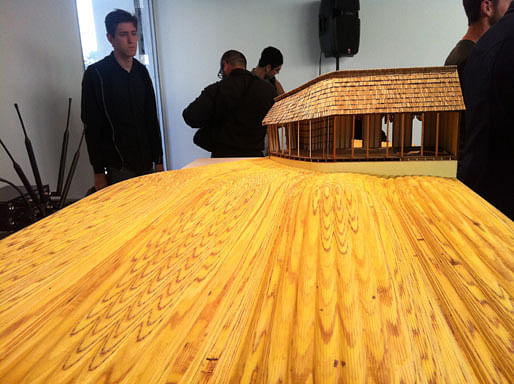
EOM questioned the topology of the landscape around the house, with its mounded extrusions. Jason stated that their form is derived from the client’s (his mother, who was never mentioned during the talk despite the unique designer/client relationship having the potential to influence the work, and in light of the history of architects designing for their mothers/parents) desire to grow different varieties of raspberries, and that their mounded nature additionally functions as ‘ha-ha walls’.
Jason was also challenged on whether the intentional faux-weathering of the curled shingle cladding constituted a romanticization of aging; he admitted this was a concern but ultimately dismissed it. He said that initially he wanted to start with all straight shingles and let the weather do the curling, but eventually shrugged off that form of true-to-concept fundamentalism, saying that it doesn’t really matter whether they start off at year 0 or at year 50 in the weathering process; he ultimately opted for something in between - ostensibly showcasing the formal/theoretical interest from the beginning, while allowing room for weathering to affect change on the work.
In the Q&A after the talk, UCLA theory prof Michael Osman brought up posture and perversity as the topics which most interested him in Raspberry Fields, and which were only glossed over in the talk. Jason dismissed the idea of perverse posture in the project, again preferring the term ‘swerve’ to perversity. He admitted though that the concept of posture cuts to the core of the genesis of the project, as well as concerns in his other work (this was also something he discussed with us in our research studio at UCLA, as well apparently with his seminar in hides at SCI-Arc). He said that he had studied the bovine form and posturing for the project in order to attempt to resist anthropomorphism, and that he intended Raspberry Fields to follow a bovine form ducking its head - generating the off-axis curve of one end of the project (the part shown in the gallery installation). Osman maintained that this attempt to avoid anthropomorphism in mining bovine posture actually made the project more evocative of the human form for him - one of supplication. I felt the same way - the hairy bovinely-slumped installation in front of us brought to mind (well, my mind anyway…) the bizarrely unexplained image from OMA’s monograph/magazine Content of a nude male model’s supplicated pose (image; NSFW unless you ‘W’ for a porn company or apparently OMA) - an image that if one reaches a bit is actually a pretty fantastic diagram of the posture of the house! At any rate, despite Jason’s design strategy of ostensibly becoming-bovine to avoid anthropomorphism, the house perhaps doesn’t fully escape the human figure after all.
SCI-Arc prof Eric Kahn found another interest in the work, saying that the project is a prompt to discuss stochasticity and ferality in architecture. In a sly response to EOM’s incredulity around Jason’s chronologically-dislodged approach to entropy in design, Kahn evoked EOM’s Petal house, saying that at 30 years old, its shingles are also ‘behaving badly’.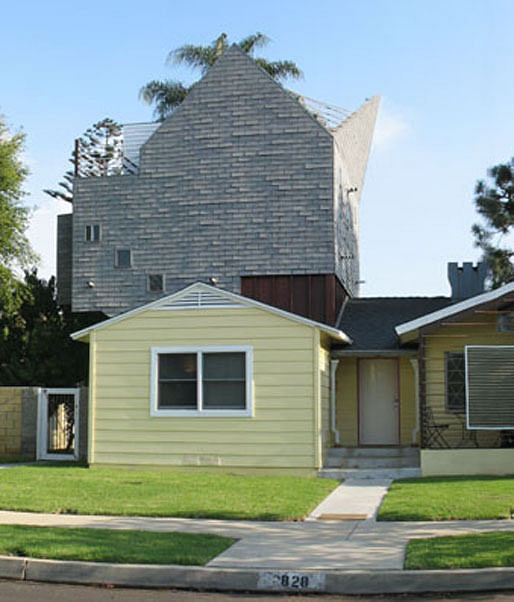
Shingles behaving badly
The exhibition ran from July 29 to September 11.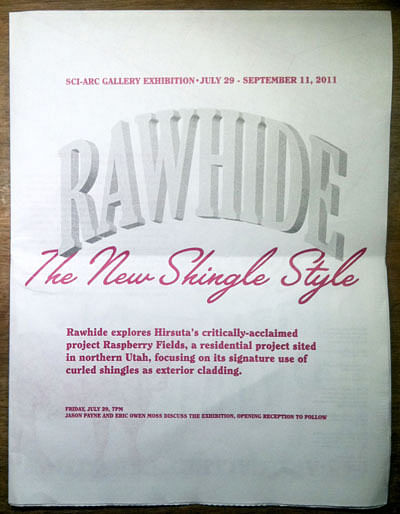
No Comments
Block this user
Are you sure you want to block this user and hide all related comments throughout the site?
Archinect
This is your first comment on Archinect. Your comment will be visible once approved.